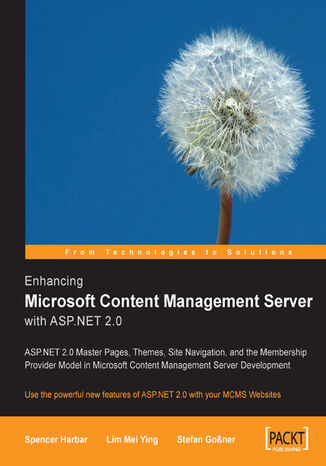Enhancing Microsoft Content Management Server with ASP.NET 2.0. Use the powerful new features of ASP.NET 2.0 with your MCMS Websites Lim Mei Ying, Spencer Harbar, Stefan Gossner




- Autorzy:
- Lim Mei Ying, Spencer Harbar, Stefan Gossner
- Wydawnictwo:
- Packt Publishing
- Ocena:
- Dostępne formaty:
-
PDFePubMobi
Opis
książki
:
Enhancing Microsoft Content Management Server with ASP.NET 2.0. Use the powerful new features of ASP.NET 2.0 with your MCMS Websites
You will first learn how to install and configure MCMS SP2. There are two approaches to setting up a development environment for SP2: an upgrade from a previous SP1a installation or starting from scratch and building a fresh installation including SP2. Of course, both approaches are covered.
You will become familiar with the MCMS Service Pack 2 development environment, and create custom Visual Studio 2005 templates to overcome some of the issues which are present with the templates shipped with MCMS SP2.
After that, its time to look at some of the most exciting features of ASP.NET 2.0, and how you can make use of them in MCMS: master pages, site navigation, themes, and the membership provider model.
One of the coolest features introduced with ASP.NET 2.0 is master pages, which allow developers to enforce common layout and behaviour across pages within an application. You will learn about the benefits of using master pages and see a step-by-step guide for implementing them in your MCMS applications, where they become master templates!
ASP.NET 2.0 introduces a whole new way of implementing site navigation, driven by site maps. By programmatically adding channels and postings to a site map you will see how to smoothly integrate these controls to any MCMS site.
To customize the look of your site, we will see how a common look and feel can be applied efficiently to a MCMS site by using ASP.NET 2.0 themes. An essential customization required for themes to work correctly in an MCMS site is a must-read feature of this chapter.
MCMS has its own role based authorization and user management system which cannot be extended. However, the new ASP.NET 2.0 Membership Provider Model and the shipped controls can be used within MCMS applications to improve the implementation of Forms Authentication and provide a more elegant solution for authenticating against an external store.
A collection of tips and tricks round off the book, including using the Provider Model design pattern to ease migration to Office SharePoint Portal Server
Wybrane bestsellery
Packt Publishing - inne książki
Dzięki opcji "Druk na żądanie" do sprzedaży wracają tytuły Grupy Helion, które cieszyły sie dużym zainteresowaniem, a których nakład został wyprzedany.
Dla naszych Czytelników wydrukowaliśmy dodatkową pulę egzemplarzy w technice druku cyfrowego.
Co powinieneś wiedzieć o usłudze "Druk na żądanie":
- usługa obejmuje tylko widoczną poniżej listę tytułów, którą na bieżąco aktualizujemy;
- cena książki może być wyższa od początkowej ceny detalicznej, co jest spowodowane kosztami druku cyfrowego (wyższymi niż koszty tradycyjnego druku offsetowego). Obowiązująca cena jest zawsze podawana na stronie WWW książki;
- zawartość książki wraz z dodatkami (płyta CD, DVD) odpowiada jej pierwotnemu wydaniu i jest w pełni komplementarna;
- usługa nie obejmuje książek w kolorze.
Masz pytanie o konkretny tytuł? Napisz do nas: sklep@helion.pl
Książka drukowana



































Oceny i opinie klientów: Enhancing Microsoft Content Management Server with ASP.NET 2.0. Use the powerful new features of ASP.NET 2.0 with your MCMS Websites Lim Mei Ying, Spencer Harbar, Stefan Gossner
(0)